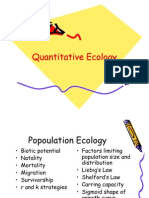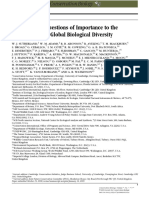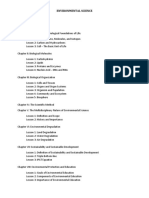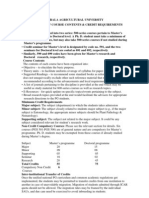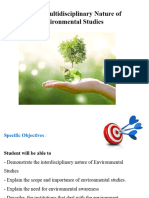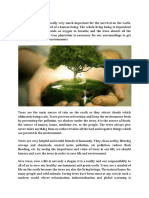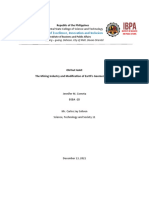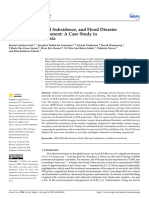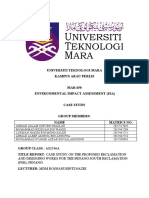Environmental Science
Environmental Science
Uploaded by
arijit_ghosh_18Copyright:
Available Formats
Environmental Science
Environmental Science
Uploaded by
arijit_ghosh_18Original Description:
Original Title
Copyright
Available Formats
Share this document
Did you find this document useful?
Is this content inappropriate?
Copyright:
Available Formats
Environmental Science
Environmental Science
Uploaded by
arijit_ghosh_18Copyright:
Available Formats
ENVIRONMENTAL SCIENCE (877)
Aims: 1. To help the student appreciate man's place in the natural systems. 2. To provide a wide understanding of knowledge resources relevant to environment protection and conservation. 3. To permit in-depth study of certain environment related areas. 4. To place environmental concerns in a technological, social, political and economic context. 5. To provide a context for understanding the role of the individual values in conservation. 6. To provide a context for the individual student to reflect on his/her beliefs and values in relation to the environment. 7. To provide an opportunity to acquire interdisciplinary skills, knowledge and understanding and to apply this logically and coherently in the field of environmental conservation. 8. To encourage student initiative and resourcefulness in action leading to environmental protection and conservation. 9. To present environmental concerns in a challenging way and thereby encourage students to consider careers in the environmental field.
CLASS XI
There will be two papers in the subject. Paper I: Theory3 hours ... 70 marks Paper II: Practical/ Project Work 30 marks PAPER I - THEORY There will be a written paper of 3 hours duration carrying 70 marks divided into two parts. Part 1 (20 marks) will consist of compulsory short answer questions from the entire syllabus. Part 2 (50 marks) will be divided into three sections. Each section will consist of three questions. Students will be expected to answer five questions choosing at least one from each section. SECTION A 1. Modes of Existence (i) Modes of existence and resource use: hunting - gathering; pastoral; agricultural; industrial. (ii) Their impact on natural resource base: energy resources; material resources; scale of catchment; quantity of resources used. (iii) Their social organisation: size of group; kinship; division of labour; access to resources. 225 (iv) Their ideology and idiom of man-nature relationship. (v) Their ecological impact: land transformation; habitat; diversity; modification of biogeochemical cycles; modification of climate; substantial use. (vi) An appreciation of the coexistence of all four modes of existence in contemporary India. (vii) Ecological conflicts arising therein. 2. Ecology (i) Concept of an ecosystem: definition; relationships between living organism, e.g. competition, predation, pollination, dispersal, food chains, webs; the environment - physical (soil, topography, climate); biotic - types of relationships (competition, mutualism, parasitism, predation, defence); soil types and vegetation; co-evolution and introduction of species. (ii) Habitats and niches: Gause's competitive exclusion principle; resource partitioning. (iii) Flow of energy: efficiencies - photosynthetic tropic - assimilation - production; tropic levels; generalised model of the ecosystem;
ecological pyramid (numbers and biomass); food webs. (iv) Nutrient cycles: generalised model; a study of carbon, nitrogen cycles (biological and geological); man's intervention; pollution as disruption of these cycles; ecosystem as a source of material and sink waste for human societies; ecological succession - causes (autogenic, allogenic and human) - patterns of successions. (v) Biomes: terrestrial; fresh water; marine; a survey of the biomes of India and their inhabitants. 3. Pollution (i) Disruption of nutrient cycles and habitats: atmospheric pollution; human activities that change the composition of the atmosphere; connection between pollution and development; local and global effects (greenhouse effect, ozone depletion) and their impact on human life; burning of fossil fuel products - effect on ecosystem and human health. (ii) Pollution control approaches - prevention and control: as applied to fossil fuel burning; the role of PCBs; industrial pollution control principles - devices - costs - policy incentives; combating global warming; the international political dimensions; third world interest; impact on economic growth. (iii) Water pollution: water cycle; pollution of surface water, ground water, ocean water; industrial pollution and its effects; domestic sewage and its treatment - techniques and appropriate technology; marine ecosystem protection and coastal zone management; soil pollution - sources - effects. SECTION B 4. Legal Regimes for Sustainable Development (i) National legislative frameworks for environment protection and conservation; survey of constitutional provisions (including directive principles); national laws; state laws in India. 226
(ii) International legal regimes: on trade and environment (GATT, WTO, IPR, TNC's, regional arrangements and preferential trade arrangements); on climate; on common resources (forests, bio-diversities, oceans and space); international institutions (UNEP, UNCTAD, WHO, UNDP, etc.); international initiatives (Earth Summit, Agenda 21). 5. Technology and Environment (i) Technological evolution and models: hi-tech; low-tech; intermediate; appropriate; traditional; interaction between technology, resources, environment and development; energy as a binding factor; the need for reorienting technology. (ii) Renewable energy: limitations of conventional sources; sources of renewable energy and their features (solar, wind, biomass, micro-hydel and muscle power). (iii) Health: incidents of disease as an indicator of the health of the environment; prevention of diseases by better nutrition, sanitation, access to clean water, etc.; communicable and noncommunicable diseases; techniques of low cost sanitation; policy and organisation to provide access to basic health service for all; the role of traditional and local systems of medicine. (iv) Biotechnology: potential; limitations. SECTION C 6. Design and Planning for Conservation and Protection Environmental
(i) Ecosystem analysis: understanding complex systems; critical and state variables as system indicators; indicators of inter-relationships; successions and systems resilience; predicting and assessing system responses to impacts and their interventions; rapid appraisal methods. (ii) Human environment interactions: quality of life vs. quality of environment; environmental issues and problems; role of belief and values; analysing brief statements for underlying values; issues analysis - separating symptoms from problems; problem identification;
identifying the players and their positions; understanding interacting problems and identifying critical control points; problems analysis; identifying variables (human behaviours, values, ecological, etc.); determining the relationships between variables; formulating questions for research; planning research; generating problems, solution, briefs and specifications. (iii) Evaluation and assessment of impacts: approaches and techniques of environment and social impact assessment; environment impact assessment as a planning tool and a decision making instrument; interpreting environment impact assessments.
(iv) Design of solutions: generating solution options; overcoming blocks in thinking; generative and lateral thinking; using criteria (social, political, ecological, technological, economic) to rank and prioritise solution ideas; check solutions for economic, social and technical viability; collation of solution into coherent plans; planning sequence and cost. PAPER II - PRACTICAL/PROJECT WORK Guidelines for Practical/Project Work are given at the end of this syllabus.
CLASS XII
There will be two papers in the subject. Paper I: TheoryPaper II: Practical/ Project WorkPAPER I - THEORY There will be one written paper of three hours duration of 70 marks divided into two parts. Part 1 (20 marks) will consist of compulsory short answer questions on the entire syllabus. Part 2 (50 marks) will consist of three sections. Each section will have three questions. The candidate will be expected to answer five questions in all choosing at least one from each section. Project work will carry 30 marks. The project needs to be done under the supervision of the teacher. The project work will be evaluated by a Visiting Examiner (who has expertise in that specific area), appointed locally and approved by the Council. SECTION A 1. Human Beings and Nature (i) Modern schools of ecological thought. (ii) Deep ecology (Gary Snyder, Earth First) vs. shallow ecology. (iii) Stewardship of land (e.g. Wendell Berry). 227 3 hours... 70 marks 30 marks (iv) Social ecology [Marxist environmentalism and socialist ecology (Barry Commoner)]. (v) Feminism. (vi) Green politics (e.g. Germany and England). (vii) Sustainable development. 2. Population and Conservation of Ecology (i) Population dynamics: factors causing population change (birth, death, immigration and emigration); relation between the factors; age structure and its significance; population pyramids; survivorship curves; three general shapes r and K strategies. (ii) Human populations (Malthusian model and demographic transition). (iii) Population regulation: growth without regulation (exponential); simple population regulation (logistic growth curve); factors regulating population size (space, food and water, territories, predators, weather and climate, parasite and diseases, disasters and self-regulation). (iv) Human population control: family planning; education; economic growth; status of women. (v) Threats to the ecosystem: habitat destruction; genetic erosion; loss of diversity; expanding agriculture; impound water; waste from
human societies; consumption.
increasing
human
and the need for indigenous approach to urban environment. 5. Sustainable Agriculture (i) Traditional agriculture in India: irrigation systems; crop varieties; techniques for maintaining soil fertility; impact of colonialism; Indian agriculture at independence - food scarcity - food import need for increasing production - the need for land reform; green revolution - HYVs fertilizers - pesticides - large irrigation projects (dams); critical appraisal of the green revolution from the view points of agro-bio diversity; soil health; ecological impact of pesticides; energy (petroleum and petrochemicals); ability to reach the poorer sections of the rural communities; sustainability - need for sustainable agriculture - characteristics for sustainable agriculture; techniques of water soil and pest management. (ii) Food: the twin problems of production and access; food situation in the world; integrated and sustainable approach to food security for the Third World. SECTION C 6. Environmental Economics and Natural Resource
(vi) Conservation: importance; the critical state of Indian forests; conflicts surrounding forested areas - populations and tribals and their rights - tourism - poaching - roads - development projects - dams; scientific forestry and its limitations; social forestry; the role of the forest department; NGOs; joint forestry management; wild life - sanctuaries, conservation and management in India; Project Tiger as a case study in conservation. 3. Monitoring Pollution (i) Pollution monitoring. (ii) Monitoring the atmosphere: techniques. (iii) International standards. and national air quality
(iv) Water testing: indicators of water quality (including B.O.D. and C.O.D.); standards of water quality; laboratory work - determination of pH, B.O.D., C.O.D. and dissolved pollutants. (v) Soil testing: indicators of soil type and quality and laboratory work. SECTION B 4. Third World Development (i) Urban-rural divide: urbanisation - push and pull factors; consequences on rural and urban sectors; future trends and projections. (ii) A critical appraisal of conventional paradigm of development from the viewpoints of sustainability, environmental impact and equity. (iii) A case study of Gandhian approach in terms of its aims and processes. (iv) Urban environmental planning and management: problems of sanitation; water management; transport; energy; air quality; housing; constraints (economic, political) in tackling the problems; inapplicability of solutions that have worked in the First World
(i) Definition: resources; scarcity and growth; natural resource accounting. (ii) GNP vs. other forms of measuring income. (iii) Economic status and welfare (net economic welfare, nature capital, ecological capital, etc.) (iv) Externalities: cost benefit analysis (social, ecological). (v) Natural capital regeneration. 7. International Relations and the Environment (i) Trans-national characteristics of environmental issues using case study of Amazonia, trade in wild life and ozone depletion.
228
(ii) Impact of international politics, national sovereignty and interest. (iii) International trade: a theoretical perspective; free trade vs. protectionism; import barriers; domestic industry vs. free trade; trans-national companies - a historical perspective (colonialism and its lasting impact today); trade between the first and the third world characteristics - terms of trade; India's international trade - characteristics - major imports and exports - foreign exchange crises - the export imperative and its impact on the environment; the case study of aquaculture in India; diversion of scarce resource from production of subsistence needs to commercial products; toxic waste trade extent and impact; Globalisation - trade regimes (WTO, GATT, IPR, etc.) and their impact on third world. (iv) International aid: agencies; advantages; limitations; need for re-orienting aid; aid vs. self-reliance. PAPER II - PRACTICAL/PROJECT WORK (Classes XI and XII) The practical/project work carrying 30 marks needs to be undertaken under the guidance of the teacher. The project will be evaluated by a Visiting Examiner (who has specific expertise in the content of the project work) appointed locally and approved by the Council.
The project work could take one of the five forms: 1. Address a current environmental problem (preferably at local or regional scale) and should include problem identification and analysis, use of secondary data as well as some collection of primary data, design of solution, documentation of the entire process in the form of a solution proposal. 2. Design and conduct an environment impact assessment. The candidates may use secondary data, demonstrate their capacity to collect and analyse primary data by incorporating some primary data collected and use it in a few sectors of their work. 3. Systematic monitoring of an aspect of the local environment over a period of at least six months. The candidate must use quantitative techniques of monitoring, sampling scientifically. The data collected must be interpreted and presented in the report. 4. Field work and training in an environmental organisation (NGOs, Industrial Pollution Control Firms, Testing Laboratories, etc.) for a period of not less than one month. This work should be focused on one area in the syllabus. The candidate will produce a paper on the area of his/her work and training which will include his/her experience and the special expertise that she/he has acquired. 5. Conduct a study on the density and population of plants growing in a particular area using the quadral method. NOTE: No question paper for Practical work will be set by the Council.
229
You might also like
- Bio 20 Unit B - Ecosystem and Population ChangeDocument16 pagesBio 20 Unit B - Ecosystem and Population Changeapi-3534478970% (1)
- A Course Outline Ecology 2014 2015Document11 pagesA Course Outline Ecology 2014 2015Jamila BestNo ratings yet
- Autecology and SynecologyDocument2 pagesAutecology and SynecologyakintobitoluwanimiNo ratings yet
- Elec 421: Environmental Issues and PoliciesDocument20 pagesElec 421: Environmental Issues and PoliciesIve EspiaNo ratings yet
- Envi Toxicology Syllabus Sample - Tox 301 Course OutlineDocument4 pagesEnvi Toxicology Syllabus Sample - Tox 301 Course Outlineemmanferrer482No ratings yet
- Quantitative EcologyDocument123 pagesQuantitative EcologyKrishnan JeevanNo ratings yet
- Laboratory Activity 1Document2 pagesLaboratory Activity 1Florence Roy P. Salvaña100% (1)
- Biogeochemical CyclesDocument31 pagesBiogeochemical CyclesJessica OliverNo ratings yet
- Alemayehu Lemessa - ThesisDocument81 pagesAlemayehu Lemessa - ThesisgezahegnNo ratings yet
- B.Sc-Agriculture 1 Semester-SyllabusDocument16 pagesB.Sc-Agriculture 1 Semester-Syllabusabhay kumarNo ratings yet
- Midterm Exam General Ecology Ws 2013-14-13900557Document2 pagesMidterm Exam General Ecology Ws 2013-14-13900557premoh0% (1)
- 02-EnVI SCI - Ecological Principles and ConceptsDocument26 pages02-EnVI SCI - Ecological Principles and ConceptsJochebed ReyesNo ratings yet
- Sem 1 - EVS SyllabusDocument9 pagesSem 1 - EVS SyllabusSmitali UkeyNo ratings yet
- Oecd Guideline For The Testing of Chemicals: Draft November 2009Document24 pagesOecd Guideline For The Testing of Chemicals: Draft November 2009SureshCoolNo ratings yet
- Fundamentals of Soil Science: NRMH 1.1 (2 + 1) First Semester B.Sc. (Hons.) HorticultureDocument38 pagesFundamentals of Soil Science: NRMH 1.1 (2 + 1) First Semester B.Sc. (Hons.) HorticultureMakarim Khusnul100% (1)
- EVSDocument7 pagesEVSsubhas9804009247No ratings yet
- Environmental Microbiology 1Document24 pagesEnvironmental Microbiology 1Larra Marie PagcaliwaganNo ratings yet
- Environmental Science MidtermDocument12 pagesEnvironmental Science MidtermJillian Cyrene LimenNo ratings yet
- 100 Important QuestionDocument11 pages100 Important QuestionEndang_Hernawa_3436No ratings yet
- Units, Symbols, and Terminologys For Plant PhysiologyDocument249 pagesUnits, Symbols, and Terminologys For Plant PhysiologyLulu NalunaNo ratings yet
- Environ (1) - StudiesDocument121 pagesEnviron (1) - StudiesYash Verma86% (7)
- Topics For Environmental ScienceDocument5 pagesTopics For Environmental ScienceRoeliza De leonNo ratings yet
- Lotka-Volterra Two Species ModelDocument2 pagesLotka-Volterra Two Species ModelMANISHNo ratings yet
- Unit-1 Environment & Natural Resources.Document94 pagesUnit-1 Environment & Natural Resources.Manav JainNo ratings yet
- PG Syllabus AgriDocument432 pagesPG Syllabus AgriJinu Madhavan100% (1)
- Lecture 1. Introduction To BiotechnologyDocument54 pagesLecture 1. Introduction To BiotechnologynoneNo ratings yet
- Environmental DisatersDocument300 pagesEnvironmental DisatersFaith RiderNo ratings yet
- Introduction To Sustainable Engineering: CourseDocument46 pagesIntroduction To Sustainable Engineering: CourseShihab KvNo ratings yet
- Practical 4: Measuring and Comparing Species DiversityDocument12 pagesPractical 4: Measuring and Comparing Species DiversityRamizah Bt Ramli RemNo ratings yet
- Forest ManagementDocument3 pagesForest Managementsandeep0109No ratings yet
- Chapter 15-Our EnvironmentDocument5 pagesChapter 15-Our EnvironmentMonika Mehan100% (11)
- Micro-Invertebrates As Bio-Indicators in The Lake Fred Stream SystemDocument13 pagesMicro-Invertebrates As Bio-Indicators in The Lake Fred Stream SystemAlex ListNo ratings yet
- Biology and EcologyDocument5 pagesBiology and EcologykarennNo ratings yet
- Environmental Science WorksheetDocument1 pageEnvironmental Science WorksheetFrederickPaigeIIINo ratings yet
- Ecosystem Types, Niche and SuccessionDocument17 pagesEcosystem Types, Niche and Successionimsrinu100% (1)
- BiotechnologyDocument27 pagesBiotechnologySunil PillaiNo ratings yet
- GEC 21 PopulationNotesDocument5 pagesGEC 21 PopulationNotesMika TrincheraNo ratings yet
- Xii - 2022-23 - Biology - RaipurDocument219 pagesXii - 2022-23 - Biology - Raipursuresh babu0% (1)
- Chapter 1 - Introduction To EcologyDocument19 pagesChapter 1 - Introduction To EcologyHaziq Iskandar ShamsulNo ratings yet
- Applied Branches of Natural Science.Document12 pagesApplied Branches of Natural Science.Anupama Praveen100% (1)
- Animal Form and Function: C E L PDocument38 pagesAnimal Form and Function: C E L PJoshua Miguel Buno0% (1)
- World: Group IVDocument55 pagesWorld: Group IVCatibog ClarisseNo ratings yet
- Resilience Theory and Thomas Vales PlantDocument14 pagesResilience Theory and Thomas Vales PlantDitaChiquelaNo ratings yet
- Whatisa Cladogram KEYDocument6 pagesWhatisa Cladogram KEYKate WebbNo ratings yet
- Rubrics For Science Investigatory ProjectDocument1 pageRubrics For Science Investigatory ProjectRobert MediavilloNo ratings yet
- Biodivesity PPT For Environment ScienceDocument19 pagesBiodivesity PPT For Environment ScienceMohammadFaisalQureshiNo ratings yet
- GIS Project ReportDocument16 pagesGIS Project ReportManuel Pozos HernándezNo ratings yet
- STS Mod6Document12 pagesSTS Mod6karen perrerasNo ratings yet
- 02 Unit I Environmental Studies-A Multidisciplinary Subject 14-01-2022Document69 pages02 Unit I Environmental Studies-A Multidisciplinary Subject 14-01-2022doramonbhaiyaNo ratings yet
- Biome Viewer WorksheetDocument3 pagesBiome Viewer WorksheetChristian VillaNo ratings yet
- Lecture 1 Environmental IssuesDocument69 pagesLecture 1 Environmental IssuesNguyễn Vũ Xuân HyNo ratings yet
- System Concept in EcologyDocument70 pagesSystem Concept in EcologyOkty Khairunnisa Wangsapraja100% (1)
- EVS SyllabusDocument3 pagesEVS Syllabusritwik kalitaNo ratings yet
- BiodiversityDocument25 pagesBiodiversityOrane CassanovaNo ratings yet
- Environmental Science Module 13-16Document41 pagesEnvironmental Science Module 13-16Ranzel SerenioNo ratings yet
- Carbon Powerpoint-2Document25 pagesCarbon Powerpoint-2api-277471896No ratings yet
- Ecology of Freshwater and Estuarine WetlandsFrom EverandEcology of Freshwater and Estuarine WetlandsDr. Darold P. BatzerRating: 4 out of 5 stars4/5 (2)
- From Populations to Ecosystems: Theoretical Foundations for a New Ecological SynthesisFrom EverandFrom Populations to Ecosystems: Theoretical Foundations for a New Ecological SynthesisNo ratings yet
- Anti Ragging Committee - Duty Roster - 2024Document1 pageAnti Ragging Committee - Duty Roster - 2024arijit_ghosh_18No ratings yet
- MAKALDocument2 pagesMAKALarijit_ghosh_18No ratings yet
- A Survey On Optical Character Recognition For Bangla and Devanagari ScriptsDocument36 pagesA Survey On Optical Character Recognition For Bangla and Devanagari Scriptsarijit_ghosh_18No ratings yet
- IntroductionToPLC DCS ApplicationIIIBrochureDocument2 pagesIntroductionToPLC DCS ApplicationIIIBrochurearijit_ghosh_18No ratings yet
- IntroductionToPLC DCS ApplicationIIIBrochureDocument2 pagesIntroductionToPLC DCS ApplicationIIIBrochurearijit_ghosh_18No ratings yet
- Vladimir Cherkassky IJCNN05Document40 pagesVladimir Cherkassky IJCNN05arijit_ghosh_18No ratings yet
- Particle Swarm OptimizationDocument54 pagesParticle Swarm Optimizationarijit_ghosh_18No ratings yet
- Geffcm Gefem: Approximate Clustering in Very Large Object DataDocument32 pagesGeffcm Gefem: Approximate Clustering in Very Large Object Dataarijit_ghosh_18No ratings yet
- TCS34725 Color Sensor User ManualDocument16 pagesTCS34725 Color Sensor User Manualarijit_ghosh_18No ratings yet
- Rohm ML8511 00FCZ05B Datasheet PDFDocument8 pagesRohm ML8511 00FCZ05B Datasheet PDFarijit_ghosh_18No ratings yet
- Wireless Sensor Networks:: Network Architectures, Protocols and ApplicationsDocument2 pagesWireless Sensor Networks:: Network Architectures, Protocols and Applicationsarijit_ghosh_18No ratings yet
- Adafruit TCS34725 Library Documentation: Release 1.0Document23 pagesAdafruit TCS34725 Library Documentation: Release 1.0arijit_ghosh_18No ratings yet
- Application For Package Tour To Lakshadweep: Please Submit in Word FormatDocument2 pagesApplication For Package Tour To Lakshadweep: Please Submit in Word Formatarijit_ghosh_18No ratings yet
- Coral Reef Packages - LakshadweepDocument31 pagesCoral Reef Packages - Lakshadweeparijit_ghosh_18No ratings yet
- MOODLE Workshop AssignmentDocument2 pagesMOODLE Workshop Assignmentarijit_ghosh_18No ratings yet
- Fuzz IeeeDocument47 pagesFuzz Ieeearijit_ghosh_18No ratings yet
- Energy BuildingsDocument1 pageEnergy BuildingsShiv AnandNo ratings yet
- CNR Module 5.1Document18 pagesCNR Module 5.1gaya3devi.2003bNo ratings yet
- STE R: Class Test Solution (IRRIGATION) 08-04-2018 Answer KeyDocument6 pagesSTE R: Class Test Solution (IRRIGATION) 08-04-2018 Answer KeySunny KashyapNo ratings yet
- Transitioning To A Progressive Green Economy in The PhilippinesDocument40 pagesTransitioning To A Progressive Green Economy in The PhilippinesEmi NaitoNo ratings yet
- Essay On Save TreesDocument21 pagesEssay On Save TreesDeepak Baliyan100% (1)
- STS 11 EssayDocument6 pagesSTS 11 EssayKISHA MICHA LUMIKID100% (1)
- Physics Project WorkDocument7 pagesPhysics Project WorkNABIN DHAKALNo ratings yet
- Environmental MovementsDocument46 pagesEnvironmental MovementsAkshat Bhadoriya100% (1)
- Revision For The Midterm Test - Grade 10 - Test 1Document4 pagesRevision For The Midterm Test - Grade 10 - Test 1LinhLyNo ratings yet
- Guidance On The Assessment of Dust From Demolition and ConstructionDocument31 pagesGuidance On The Assessment of Dust From Demolition and ConstructionDen OpialaNo ratings yet
- Environmental Law-PollutionDocument20 pagesEnvironmental Law-PollutionJitendra RavalNo ratings yet
- Water PollutionDocument14 pagesWater PollutionMahmudur Rahman60% (10)
- Road Map - Compliance To IRMA, ISO 14001 & IFC Standards - SCM - FinalDocument15 pagesRoad Map - Compliance To IRMA, ISO 14001 & IFC Standards - SCM - FinalyanurulNo ratings yet
- Architectural Design Brief PDFDocument4 pagesArchitectural Design Brief PDFVenumadhavi YerraguntaNo ratings yet
- 250+ TOP MCQs On Strategies To Control Environmental Pollution and AnswersDocument5 pages250+ TOP MCQs On Strategies To Control Environmental Pollution and AnswersRCNo ratings yet
- Organic Liquid FertilizerDocument1 pageOrganic Liquid FertilizerJL PerezNo ratings yet
- Kebede Merga Senior EssayDocument46 pagesKebede Merga Senior EssaydesalegnmeliseNo ratings yet
- 2024 - Sea Level Rise, Land Subsidence, and Flood Disaster Vulnerability Assessment A Case Study in Medan CityDocument18 pages2024 - Sea Level Rise, Land Subsidence, and Flood Disaster Vulnerability Assessment A Case Study in Medan CityfajarNo ratings yet
- Forests 14 00245Document14 pagesForests 14 00245laymohlaNo ratings yet
- Term 2 - Grade 8 Science Chapter 6 Conservation of Plants and AnimalsDocument3 pagesTerm 2 - Grade 8 Science Chapter 6 Conservation of Plants and Animalsris.aryajoshiNo ratings yet
- Vetiver System - A Green Investment For Sustainable Development.Document20 pagesVetiver System - A Green Investment For Sustainable Development.api-19745097No ratings yet
- Fishery Simulation LabDocument4 pagesFishery Simulation Labapi-237363604No ratings yet
- AGR 3102-1st WeekDocument44 pagesAGR 3102-1st WeekSleeping BeautyNo ratings yet
- AgrochemicalsDocument31 pagesAgrochemicalsSushma SannidiNo ratings yet
- Waste Management PlanDocument6 pagesWaste Management PlanBrenda GreenNo ratings yet
- Tarun Bharat Sanghs Work at AlwarDocument5 pagesTarun Bharat Sanghs Work at AlwarAnshuman SardarNo ratings yet
- Evaluation of Water Equality of Major Rivers in Palawan Using Physico-Chemical Parameters and Water Quality IndexDocument13 pagesEvaluation of Water Equality of Major Rivers in Palawan Using Physico-Chemical Parameters and Water Quality IndexMark Ian EspirituNo ratings yet
- Case Study - Penang South ReclamationDocument32 pagesCase Study - Penang South ReclamationApe Apeje100% (1)
- Their Home, Their Voyage: Michael E. "Mike" Reynolds Is An AmericanDocument2 pagesTheir Home, Their Voyage: Michael E. "Mike" Reynolds Is An AmericanCRISTOPHER ANDREW CARDENAS TUESTANo ratings yet
- Writ of KalikasanDocument18 pagesWrit of Kalikasanraymond gwapoNo ratings yet





